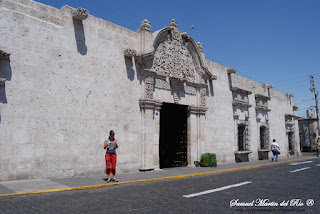 Arequipa is the capital of the Arequipa Region in southern Peru. With a population of 904,931 (2009 – World-Gazetteer.com) it is the second most populous city of the country. Arequipa lies in the Andes mountains, at an altitude of
Arequipa is the capital of the Arequipa Region in southern Peru. With a population of 904,931 (2009 – World-Gazetteer.com) it is the second most populous city of the country. Arequipa lies in the Andes mountains, at an altitude of  O world heritage site in
O world heritage site in Archaeological findings indicate the fertile valley where Arequipa is situated has been occupied back to 5000–6000 BCE. In the 15th century, the region, then occupied by Aymara Indians, was conquered by the Inca and served as an important supplier of agrarian products to the Inca Empire. The modern city of Arequipa was founded on 15 August 1540, by Garcí Manuel de  Carbajal, an emissary of Spanish conquistador Francisco Pizarro. Arequipas' first mayor was D. Juan de
Carbajal, an emissary of Spanish conquistador Francisco Pizarro. Arequipas' first mayor was D. Juan de
This led Arequipa to develop a large mestizo population as its demographics changed and grew over the centuries. Since the late 1940s, however, there has been a huge and increasing immigration from the Peruvian sierra, thus changing the demographic and cultural character of the city.
develop a large mestizo population as its demographics changed and grew over the centuries. Since the late 1940s, however, there has been a huge and increasing immigration from the Peruvian sierra, thus changing the demographic and cultural character of the city.
Arequipa remained relatively isolated during colonial and early republican times, but that changed in 1870 when a southern railroad to the coastal port of Mollendo was inaugurated, opening trade to the Pacific Ocean. The building and expansion of more roads in the 1930s also led to a  direct connection with the Pan-American Highway, strengthening Arequipa's links to the rest of the Americas. Since then, the city has remained the center of commerce between Lima and all of southern Peru.
direct connection with the Pan-American Highway, strengthening Arequipa's links to the rest of the Americas. Since then, the city has remained the center of commerce between Lima and all of southern Peru.
Arequipa served as a bastion of nationalism during Peru's struggle for independence from Spain in the early 19th century. Later, it served as a rallying point during the War of the Pacific (1879–1883) with Chile.
Villages from pre-Incan times are still in use today by many farm ers. Some of these farmers are from the districts of Chilina, Socabaya, Paucarpata, Characato, and Sabandia.
ers. Some of these farmers are from the districts of Chilina, Socabaya, Paucarpata, Characato, and Sabandia.
Arequipa has experienced many earthquakes. It was almost destroyed by one in 1868 (more of 10,000 killed), and on June 23, 2001 (at least 24 killed in the city), Arequipa was badly damaged by an earthquake of 7.9 on the Richter scale.
In June 2002, Arequipa was completely paralyzed for a week by strikes and riots in protest of the privatization of two regional electricity-generating plants.
 The Historic centre of Arequipa, keeps most of the important buildings from the Spaniard era. They are all built in volcanic sillar rock, and the whole complex represents an integration of European and native building techniques and characteristics, expressed in the admirable work of colonial masters and Criollo and Indian masons. This combination of influences is illustrated by the city's robust walls, archways and vaults, courtyards and open spaces, and the intricate Baroque decoration of its facades.
The Historic centre of Arequipa, keeps most of the important buildings from the Spaniard era. They are all built in volcanic sillar rock, and the whole complex represents an integration of European and native building techniques and characteristics, expressed in the admirable work of colonial masters and Criollo and Indian masons. This combination of influences is illustrated by the city's robust walls, archways and vaults, courtyards and open spaces, and the intricate Baroque decoration of its facades.
There are several walkin g routes available to enjoy the centre. Most of them start in the Plaza (main square) and cover five or six blocks. Most maps include the important buildings along the centre streets. The newly created pedestrian mall at Mercaderes Street, historic Arequipa's main shopping street, is another important walking route. Lining Mercaderes Street are buildings of numerous architectural styles, ranging from traditional colonial, art deco, to contemporary.
g routes available to enjoy the centre. Most of them start in the Plaza (main square) and cover five or six blocks. Most maps include the important buildings along the centre streets. The newly created pedestrian mall at Mercaderes Street, historic Arequipa's main shopping street, is another important walking route. Lining Mercaderes Street are buildings of numerous architectural styles, ranging from traditional colonial, art deco, to contemporary.
Some other well-preserved touristic areas within the historic core are the pedestrian-friendly San Lazaro neighborhood (east from the Main Square) and the Yanahuara district, located north and connected to the centre by two historic  stone bridges.
stone bridges.
September 2009










Comments "AREQUIPA, PERU"
Post a Comment